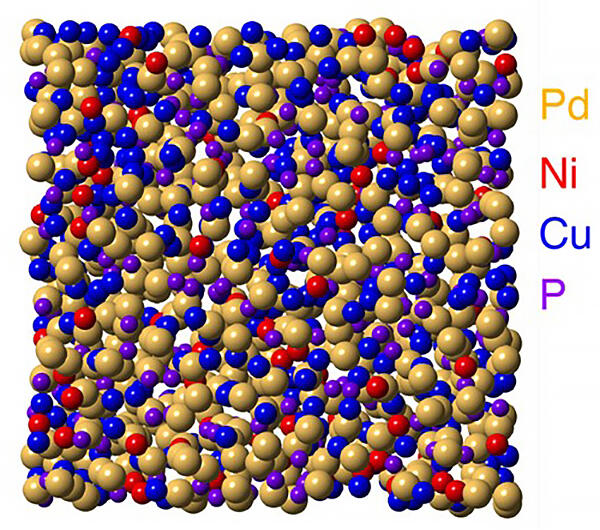Special Professor Shinya Hosokawa and Visiting Professor László Pustai (concurrently of the Hungarian Academy of Sciences) at the Institute of Industrial Nanomaterials, Kumamoto University, have collaborated with the French National Centre for Scientific Research (CNRS), the University of Marburg in Germany, Japan Synchrotron Radiation Research Institute (JASRI), the National Institute for Materials Science (NIMS), the Institute for Materials Research, Tohoku University, the Institut Laue-Langevin (ILL) in France, and the University of Bath in the U.K., to conduct anomalous X-ray scattering experiments using synchrotron radiation and neutron diffraction experiments using a strong neutron source. The researchers succeeded in capturing the characteristics of the atomic ordering of palladium (Pd)-nickel (Ni)-copper (Cu)-phosphorus (P) metallic glass Pd42.5Ni7.5Cu30P20 (PNCP), which can currently form the largest bulk shape of metallic glass, exceeding 8 cm.

Provided by Kumamoto University
Unlike ordinary transparent glass, metallic glass has been thought to be difficult to make because its atoms have a discorded structure, but after about the year 2000, it became possible to make large lumps of centimeter-size glass. However, only some empirical rules have been proposed in the past as to what combination of metallic elements would facilitate the creation of a glassy state, and it was far from being a modern precision science.
This study focused on distinguishing the role of each constituent element (Pd, Ni, Cu, and P) with respect to atomic arrangement and finding their associated characteristics. In order to do this, the researchers collected five types of data with different elemental contributions with the highest accuracy in the world by using X-ray anomalous scattering experiments and neutron diffraction experiments. They used the reverse Monte Carlo method to analyze their results and employed Voronoi and persistent homology methods to examine the atomic sequences they obtained. By comparing the results in detail with those of Pd40Ni40P20 (PNP) and Pd40Cu40P20 (PCP), which are mother alloys and have slightly lower glass-forming ability, they were able to characterize the atomic ordering directly linked to the ability to form glass.
Regarding the glass-forming ability of metallic glasses, it has recently been suggested that atomic groups with different properties compete, making it difficult for them to crystallize. The researchers concluded that in the case of PNCP metallic glasses, the somewhat covalent nature of Pd-P competes with the metal clusters formed by Ni and Cu secondary metals to produce superior glass-forming ability.
"It is very interesting to see if the results of this experiment show the same trend as metallic glasses made of other elements," says Hosokawa. "Moving forward, we would like to consider researching atomic arrangements for metallic glasses with zirconium (Zr) as the main metallic element. If the results are similar, this discovery will be extremely significant for the development of more stable metallic glasses."
■ Reverse Monte Carlo method: an analysis method performed from the standpoint of a "reverse problem" that attempts to reproduce the experimental data from a certain model of the atomic arrangement as opposed to the regular method in which a mathematical analysis called Fourier transform is performed on experimental data to obtain the atomic arrangement.
■ Voronoi analysis: A means of determining how neighboring atoms are arranged around a central atom.
■ Persistent homology: A topological (topological or shape science) analysis that extracts the arrangement of an object.
Journal Information
Publication: Journal of Non-Crystalline Solids
Title: Relationship between atomic structure and excellent glass forming ability in Pd42.5Ni7.5Cu3 0P2 0 metallic glass
DOI: 10.1016/j.jnoncrysol.2022.121868
This article has been translated by JST with permission from The Science News Ltd.(https://sci-news.co.jp/). Unauthorized reproduction of the article and photographs is prohibited.




